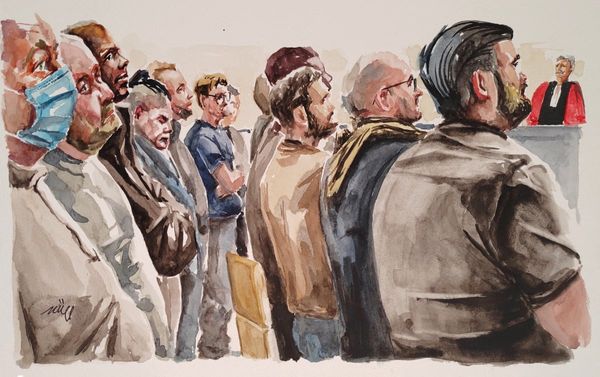The UK awoke on Monday morning to the news that Hollywood A-lister Will Smith had slapped comedian Chris Rock at the Oscars after making a joke about his wife Jada Pinkett Smith's "GI Jane" haircut. In a shocking scene that was broadcast live around the world, Smith strode onto the stage and attacked Rock before walking back to his seat in the audience and shouting: "Keep my wife's name out of your f*****g mouth".
The jibe about Pinkett Smith's bald head clearly touched a nerve with the former Fresh Prince star as his wife had previously spoken candidly about her hair loss from alopecia. In December, she discussed her experience with the condition in an Instagram video, in which she pointed out a line that developed around her scalp.
She first revealed she had the disorder in 2018 during which she recalled losing "handfuls" of hair. She said: "It was terrifying when it first started. I was in the shower one day and then just handfuls of hair, just in my hands, and I was like 'Oh my God, am I going bald? It was one of those times in my life when I was literally shaking with fear". Despite the condition being relatively common, there remain misconceptions among the general public around alopecia, what causes it and how it can be treated.
Alopecia UK has issued a statement saying it "does not condone violence in any form". It said: "Dealing with unwelcome remarks and being the butt of jokes is sadly an all too real part of having alopecia. This just adds to the distress and challenges faced by people with alopecia. In a world where it's unacceptable to make jokes about someone's race, sexuality or disability, we believe the same should apply to jokes about visible difference. Such remarks or jokes should be called out as unacceptable or inappropriate.
"At Alopecia UK, we understand the difficult emotions that people affected by alopecia may feel, including loved ones of people with the condition. Alopecia UK is here to support anyone affected by any type of alopecia."
Here, Alopecia UK explains a bit more about the condition
Read more: Why am I so bloated? The seven main causes and what to do
What is Alopecia Areata?
Alopecia areata is thought to be an autoimmune condition which often starts with isolated patches of hair loss, commonly in one or more coin-sized (usually round or oval) patches on the scalp and/or across the body including the beard, eyebrows, eyelashes or body hair, including pubic hair.
In alopecia areata, cells from the immune system (a specific type of T cell, known as NKG2D+ T cells) gather around the hair follicles. These cells attack the follicle, stopping it from producing more hair. The exact way in which this happens is not yet understood.
Are there different types of Alopecia Areata?
Alopecia areata can take several different forms:
Alopecia Areata (patchy hair loss): Alopecia areata shows up as round or oval patches on the scalp or other places on the body that grow hair. This type of alopecia areata can sometimes develop into either alopecia totalis (hair loss across the entire scalp) or alopecia universalis (hair loss across the entire body), but in most cases it remains patchy and eventually regrowth occurs. For some people with alopecia areata the patchy hair loss continues over a long period of time, without ever developing into alopecia totalis or alopecia universalis: this is sometimes referred to as 'persistent patchy alopecia areata' or 'chronic alopecia areata'.
Alopecia Totalis: Alopecia totalis is characterised by a total loss of all scalp hair. For some people, the hair loss begins as typical alopecia areata patches. However, some people experience such rapid hair loss that patches are not seen before most of the scalp hair is lost.
Alopecia Universalis: Alopecia universalis is characterised by hair loss across the entire scalp, face (including eyebrows and eyelashes), and the rest of the body (including pubic hair). Please note, many people experience forms of alopecia areata that are somewhere between alopecia totalis and alopecia universalis, so can lose some but not all body hair, or some but not all facial hair.
Diffuse Alopecia Areata (Alopecia Areata Incognita): Diffuse alopecia areata is characterised by sudden thinning of the hair all over the scalp rather than patches of hair loss. This condition is sometimes also referred to as 'alopecia areata incognita'. This condition can be hard to diagnose because it looks very similar to other types of hair loss, namely telogen effluvium and androgenetic alopecia (male or female pattern hair loss).
Alopecia Areata Ophiasis: Alopecia areata ophiasis has a specific pattern of hair loss, where hair falls out from the sides and lower back of the scalp. Alopecia areata ophiasis can be more difficult to treat because it does not respond as quickly to medication. There is a less common form of this type of alopecia areata, called alopecia areata sisaipho, where the hair is lost from the front of the scalp, forehead and rarely the eyebrows.
Alopecia Barbae: Alopecia barbae is a form of alopecia areata, in which hair loss affects the beard and moustache. Alopecia barbae can occur only in the beard area, but can also happen alongside hair loss in other areas, such as the scalp. Alopecia barbae usually causes beard hair to fall out in small circular patches. If more hair is falls out, the circles can begin to overlap. Hair around the edge of the patches sometimes turns white.
Does the condition affect anything other than hair?
Between 10–50% of people with alopecia areata also experience nail complications: the most common symptoms are pitting and ridging of the nails.
What are the symptoms of Alopecia Areata?
The first symptom of alopecia areata is often sudden patchy hair loss. The patches of hair loss can grow larger. Sometimes, the patches grow larger and join up. In some people, hair can fall out so fast that all the scalp hair is lost without any patches appearing. Many people do not experience pain or other symptoms from alopecia areata. However, in some people, hair loss can be accompanied by tingling, itching, burning, headaches or even pain in the skin.
What causes Alopecia Areata?
Alopecia areata can affect both men and women of any age. In about 50% of cases, it starts in childhood. About one in 1,000 people have a form of alopecia areata, independent of ethnicity. A family history of alopecia areata and/or of other autoimmune conditions are present in 10–25% of patients.
People with alopecia areata are not only more likely to have other autoimmune diseases (such as thyroid disease or vitiligo) but they are also more likely to have atopic conditions (such as eczema, asthma, hayfever and atopic dermatitis). Alopecia areata is more common in people with chromosomal disorders such as Down's syndrome. It is what is known as a 'polygenic condition'. This means that both parents must contribute a number of specific genes in order for a child to develop it.
We still don't know what "triggers" the immune system to attack healthy hair follicles when people have alopecia areata, or even if these triggers first happen inside the body (eg. from an infection) or outside the body (from something in your environment) and it could easily be combination of both of these. This blog post from Professor Kevin McElwee explains in greater detail about the causes of alopecia areata.
How is Alopecia Areata diagnosed?
Alopecia areata is diagnosed by your doctor. Sometimes, extra tests are needed to confirm the diagnosis. These can include trichoscopy (an examination of the hair and scalp under a microscope) or a skin biopsy.
How long will Alopecia Areata last?
Alopecia areata does not cause permanent hair loss. The hair follicles are not destroyed, and hair does have the possibility to re-grow. Usually, in patchy alopecia areata, hair will regrow over a period of months or years, but regrowth cannot be guaranteed. Many people with alopecia areata do experience full regrowth. However once the condition has developed to alopecia totalis or alopecia universalis, the chances of full regrowth become smaller. It is quite common for people with alopecia areata to experience hair loss on and off throughout their lives.
Is there a cure for Alopecia Areata?
There is currently no cure for alopecia areata, however, there are a variety of treatments on offer: unfortunately, none are guaranteed to work. Many people experience spontaneous regrowth without treatment. Treatments are more likely to be effective in milder cases of Alopecia Areata, with small patches of hair loss.
Common treatments for alopecia areata include corticosteroids (designed to dampen down the immune response), topical immunotherapy (to distract the immune response). New therapies on the horizon include JAK-inhibitors, which suppress specific parts of the immune system. For more information about treatments, please click here.
Is Alopecia Areata inherited?
In about 20% of cases, alopecia areata is inherited. Alopecia areata is a 'polygenic condition', so there are several genes involved. As well as a specific set of genes, your environment also contributes to developing alopecia areata. Most children with alopecia areata do not have a parent with the disease, so most people with the condition do not pass it down to their children.







